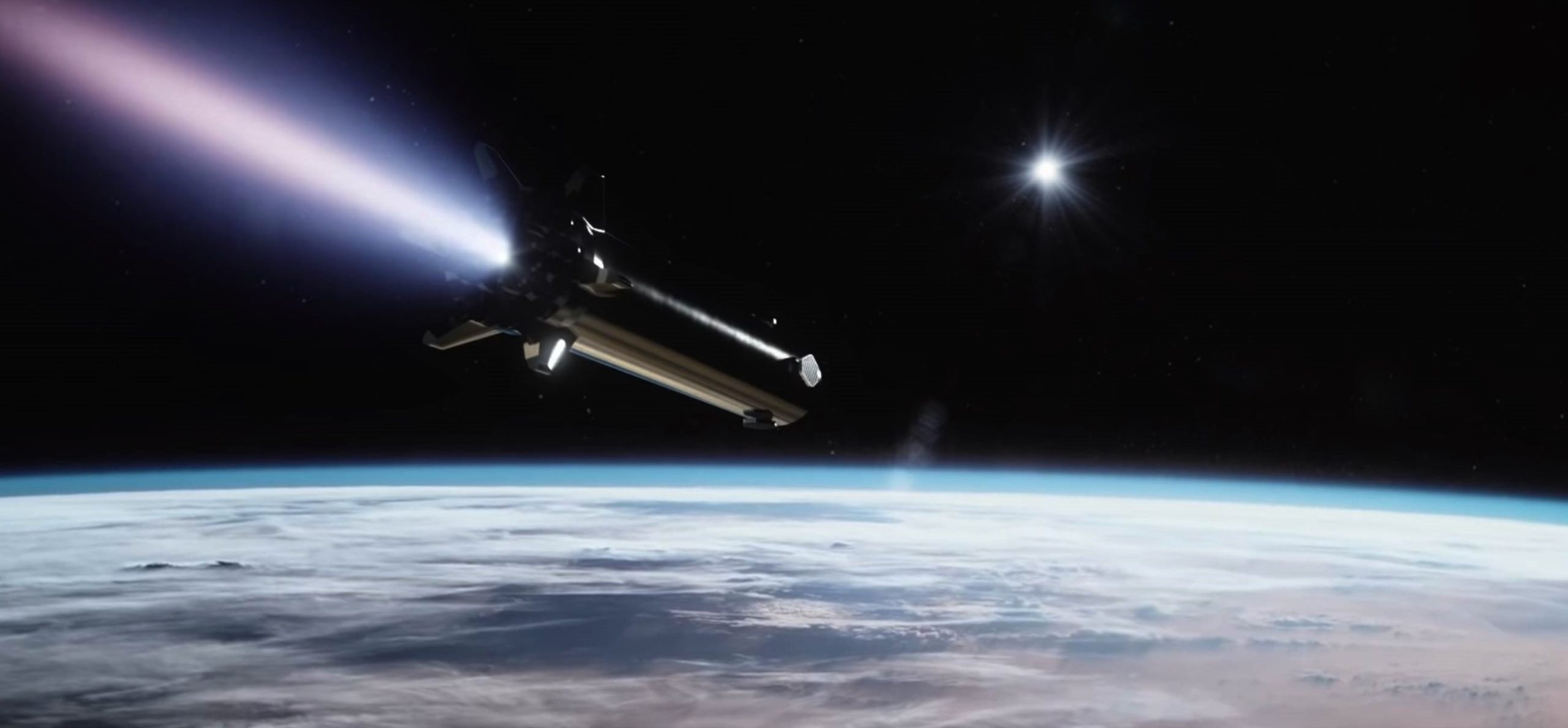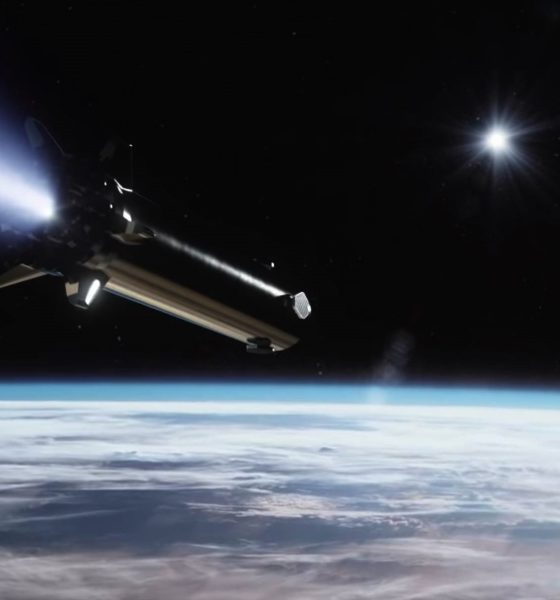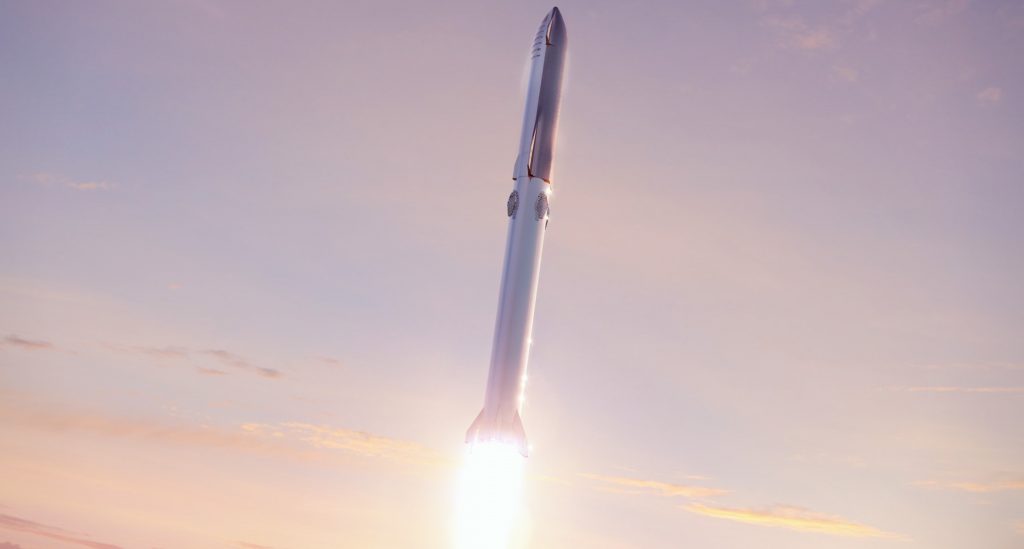

News
SpaceX Super Heavy booster assembly to start “this week,” says Elon Musk
CEO Elon Musk says that SpaceX is on track to begin fabricating Starship’s first Super Heavy booster prototype later “this week” and even revealed plans to hop that booster in the very near future.
Taller than an entire two-stage Falcon 9 or Falcon Heavy rocket, Super Heavy will be the largest and most powerful liquid rocket booster ever built by a factor of two (or more). Measuring ~70m (~230 ft) tall, Super Heavy will weigh at least 3500 metric tons (7.7 million lb) when fully loaded with liquid oxygen and methane propellant. According to Musk, SpaceX’s thrust target for the booster is 7500 tons (~16.5 million lbf) – significantly more than twice the thrust of the Saturn V and Soviet N-1 rockets and more than three times the thrust of SpaceX’s own Falcon Heavy.
On paper, while multiple times larger and more powerful, Super Heavy will be substantially simpler than Falcon Heavy thanks to its single-core. Built out of the same simple steel rings used to assemble Starship prototypes, Super Heavy should also be substantially cheaper to build than Falcon Heavy. Thanks to the experience SpaceX has already gained through months of Starship production, testing, and iterative improvement, initial Super Heavy prototype production could have a much smoother start, but several major challenges remain.

SpaceX has structured its Starship development program in such a way that the hardest technical challenges are generally first in line. Raptor engine testing came first in September 2016, although SpaceX did simultaneously build and test a full-scale carbon composite liquid oxygen – a material choice that was ultimately made redundant by the move to steel in late 2018. Up next, Starhopper served as a sort of proof of concept for the assembly of a flightworthy steel rocket in an unprotected open-air tent.
Starship Mk1 came next and was built as a full-scale prototype in similarly spartan conditions – but with much thinner steel. Mk1 ultimately failed prematurely, serving as a catalyst for SpaceX to substantially upgrade its South Texas rocket production capabilities, as well as its manufacturing techniques. Beginning in January 2020, SpaceX completed a rapid-fire series of tests with three stout tank prototypes and five full-scale Starship tank sections over the next seven months, passing multiple challenging pressure tests, wet dress rehearsals, Raptor static fires, and even a 150m (500 ft) hop.
The biggest challenges still facing Starship (5+ minute Raptor burns, skydiver-style landings, heat shield qualification, orbital launch/reentry/reuse) are mostly unique to the orbital spacecraft. In other words, with all SpaceX has already accomplished so far with Starship development, it could very well be ready to build a fully-capable Super Heavy prototype right now.
Along those lines, Musk says that there’s a chance that SpaceX will be ready to hop a Super Heavy booster prototype as early as October 2020 – less than two months after the first prototype enters production. Musk also noted that the biggest technical challenge facing Super Heavy is its extraordinarily complex ‘thrust puck’ – a metal structure that must host up to 28 Raptor engines and transfer all of their thrust through the rest of the rocket.
Per past comments, SpaceX will begin booster testing – possibly up to and including the first few orbital launch attempts – with as few Raptor engines as possible. For Musk’s aforementioned booster hop test, Super Heavy could reportedly hop with as few as two Raptors installed. Beyond those early tests and Super Heavy thrust puck development, perhaps only other challenge facing SpaceX is finalizing Raptor’s design to the point that dozens of engines can be built in short order. As of now, SpaceX has completed 40 Raptor prototypes in 18 months, while every Starship/Super Heavy pair will need as many as 34 engines apiece.
Check out Teslarati’s Marketplace! We offer Tesla accessories, including for the Tesla Cybertruck and Tesla Model 3.

Elon Musk
Elon Musk’s Biggest Revelations on AI, Robots, and the Future of Work from the Moonshots Podcast

Elon Musk’s appearance on the Moonshots with Peter Diamandis podcast was packed with bold predictions, candid admissions, and surprising tech insights. The nearly three-hour conversation covered everything from artificial intelligence to humanoid robots, geopolitics, and the future of work. Here are the top 10 most intriguing takeaways:
-
Aggressive AGI Timeline Predictions
Musk offered a detailed view on when artificial general intelligence (AGI) could emerge, suggesting it may arrive sooner than many expect, emphasizing both transformative potential and risks.
-
U.S. vs. China in the AI Race
He discussed the strategic competition between the United States and China over AI development, noting that geopolitical dynamics will shape how and who leads in the next decades.
-
Future of Job Markets
Musk touched on how AI and automation could reshape employment, predicting massive boosts in productivity alongside potential disruptions in traditional work structures.
-
Clean Energy Transition
A recurring theme was the role of clean energy in future economies, with Musk reiterating the importance of scaling sustainable power generation and storage.
-
Humanoid Robots Are Coming
On the podcast, Musk elaborated on Tesla’s work on humanoid robots, hinting at timelines and applications that go beyond factories to general-purpose assistance.
-
Tesla Roadster “Last Human-Driven Car”
Outside the core discussion topics, Musk teased features of the upcoming Tesla Roadster — calling it “the best of the last of the human-driven cars” and suggesting safety won’t be its main selling point.
-
The Role of AI in Clean Energy and Robotics
Linking AI to both energy optimization and robotics, Musk explained how smarter systems could accelerate decarbonization and task automation across industries.
-
U.S. Innovation Leadership
Musk argued that maintaining American leadership in key tech sectors like AI, space, and robotics should be a national priority, with thoughtful policy and investment.
-
Job Creation vs. Job Elimination
While acknowledging automation’s disruptive effects, he also outlined scenarios where new industries and opportunities could emerge, particularly in AI, space, and advanced manufacturing.
-
Long-Term Vision for Humanity
Throughout the conversation, Musk revisited his long-term philosophical views — including a belief in humanity’s responsibility to become a multi-planetary and technologically empowered species.
Whether you agree with Musk’s optimism or not, the podcast offers a window into the thinking of one of the most influential figures in tech today, in and why his visions continue to spark debate and inspiration.
Elon Musk
Elon Musk just said some crazy stuff about the Tesla Roadster

Elon Musk appeared on the Moonshots podcast with Peter Diamandis today to discuss AGI, U.S. vs. China, Tesla, and some other interesting topics, but there was some discussion about the upcoming unveiling of the Roadster, the company’s electric supercar that will arrive several years after it was initially slated for release.
Musk made some pretty amazing claims about the Roadster; we already know it is supposed to be lightning-fast and could even hover, if Tesla gets everything to happen the way it wants to. However, the car has some pretty crazy capabilities, some of which have not even been revealed.
On the podcast, Musk said:
“This is not a…safety is not the main goal. If you buy a Ferrari, safety is not the number one goal. I say, if safety is your number one goal, do not buy the Roadster…We’ll aspire not to kill anyone in this car. It’ll be the best of the last of the human-driven cars. The best of the last.”
🚨 Elon on the Roadster unveiling, scheduled for April 1:
— TESLARATI (@Teslarati) January 6, 2026
Musk makes a good point: people who buy expensive sports cars with ridiculous top speeds and acceleration rates do not buy them to be safe. They hope they are safe in case of an emergency or crash, but safety is not at the forefront of their thoughts, because nobody buys a car thinking they’ll crash it.
The Roadster is truly going to push the limits and capabilities of passenger vehicles; there’s no doubt about that. Tesla plans to show off the new version car for the first time on April 1, and Musk has only hinted at what is possible with it.
Musk said back in November:
“Whether it’s good or bad, it will be unforgettable. My friend Peter Thiel once reflected that the future was supposed to have flying cars, but we don’t have flying cars. I think if Peter wants a flying car, he should be able to buy one…I think it has a shot at being the most memorable product unveiling ever. [It will be unveiled] hopefully before the end of the year. You know, we need to make sure that it works. This is some crazy technology in this car. Let’s just put it this way: if you took all the James Bond cars and combined them, it’s crazier than that.”
Production is set to begin between 12 and 18 months after the unveiling, which would put the car out sometime in 2027. Hopefully, Tesla is able to stay on track with the scheduling of the Roadster; many people have been waiting a long time for it.
News
Tesla launches hiring for Robotaxi program in its twentieth country
Overall, the hiring signals Tesla’s aggressive timeline for global dominance in autonomous mobility.

Tesla has launched a hiring initiative for its Robotaxi program in its twentieth country, as the company posted two new jobs in Thailand this week.
Tesla is hiring in Bangkok and Kowloon for the Vehicle Operator position, which is related to data collection, and is the first in Thailand, but the twentieth country overall, as the company tries to expand into other markets.
🚨 BREAKING: Tesla is hiring additional full-time Vehicle Operators in Bangkok, Thailand.
Previous openings were 6-month, part-time roles. These are equivalent to AI Safety Operator roles in the U.S. pic.twitter.com/R6LzoU1bos— Tesla Yoda (@teslayoda) January 5, 2026
Tesla has had active job postings for Vehicle Operator positions in the United States, India, Israel, Taiwan, Germany, the Czech Republic, Hungary, the UK, Finland, Switzerland, Sweden, the Netherlands, Austria, Spain, Norway, Italy, and Turkey in past listings.
These postings are not all currently available, likely because the roles have been filled.
Thailand is the most recent, and broadens the company’s potential path to expanding its ride-hailing program, which is only active in the United States in Austin, Texas, and the California Bay Area, so far.
These roles typically involve data collection, which assists in improving Autopilot and Full Self-Driving operation. Tesla’s self-driving programs utilize real-world data that is accumulated and stored, observing vehicle and traffic behavior, as well as tendencies that are performed by human drivers to help increase safety and overall performance.
Overall, the hiring signals Tesla’s aggressive timeline for global dominance in autonomous mobility. Although the company has several high-profile rivals and competitors in the field, it has established itself as a main player and a leader in the development of autonomous technology, especially in the U.S., as its FSD suite is refined on almost a weekly basis.
The Full Self-Driving suite is available in seven countries and territories currently, including the U.S., Canada, China, Mexico, Puerto Rico, Australia, and New Zealand. Its biggest goal for expansion is currently the European market, where regulatory hurdles have been the main bottleneck prolonging its launch on the continent.
Tesla has performed months of testing in various European countries, including France and Spain, and does have support in some areas from various regulatory agencies. However, the company is hoping to get through this red tape and offer its suite in Europe for the first time, hopefully this year.








